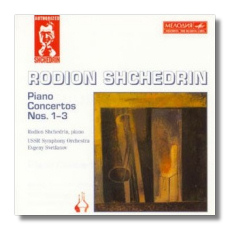
The Internet's Premier Classical Music Source
Related Links
- Latest Reviews
- More Reviews
-
By Composer
-
Collections
DVD & Blu-ray
Books
Concert Reviews
Articles/Interviews
Software
Audio
Search Amazon
Recommended Links
Site News
 CD Review
CD Review
Rodion Shchedrin

Piano Concertos
- Piano Concerto #1
- Piano Concerto #2
- Piano Concerto #3
Rodion Shchedrin, piano
USSR Symphony Orchestra/Evgeny Svetlanov
Melodiya 74321 36907 2 (BMG Classics)
Such a potpourri of styles! Rodion Shchedrin's Piano Concerto #1 (1954) is a playful work, composed when he was twenty-two. It shows. Indeed, the piece wears preciousness over its shoulder like a maroon sash. Its bouncy final movement (Presto festoso), with its repetitive melodies and sweeping tutti, resembles the first movement of Tchaikovsky's Piano Concerto #1. Even though Shchedrin revised it twenty years later, he didn't modernize it. This concerto could be a pastiche concerto from the late Romantic era. Yet Shchedrin plays it so seriously, there is no room for ironic high jinks.
In Piano Concerto #2 (1966), Shchedrin turns chameleon. No longer a sentimentalist, he peppers the meal with dissonance. Mixing twelve-tone compositional techniques with traditional ones (like recapitulation and development), this piece dives and thrashes about, never losing its backbone of Shchedrin showmanship. Don't play it before going to sleep. The piano shakes the orchestra as if trying to wake it up. The orchestra snarls and squirms and – it's all great fun. In the final movement, Shchedrin seems to imitate Shostakovich during the Andante and inserts a jazzy, American-style xylophone passage during the Allegro.
Piano Concerto #3 (1973) is his most sophisticated. It uses thirty-three variations on a theme (perversely unstated until the end). Sometimes Shchedrin plays eerie night music, other times it's high-pitched white-key tones. Meanwhile, the orchestra rumbles, as if the musicians are champing at the bit, but Shchedrin won't let them loose. Not as bumptious as the second, the concerto is so aleatory, it seem as if the piano and orchestra aren't working together. But they are. In the pensive final movement, the orchestra disappears until the coda, inexplicably puncturing the silence with symbol chords played diminuendo. This CD's a cornucopia of wild fun.
Copyright © 1997, Peter Bates


















